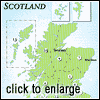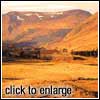|
Introduction

Scotland is situated on the northwest flank of Europe,
the Atlantic Ocean splintering its craggy, western coastline while the tempestuous
North Sea dividing its eastern shores from Scandinavia and the Low Countries. Small
in comparison to most, the country of Scotland, for those that have lived here, visited
or simply beheld its images on page or screen, exercises a peculiar hold on the heart.
The nation's enduring symbols, despite the tourist
board's constant attempts to remodel them, are fairy-tale glens, medieval castles,
swirling kilts, squealing bagpipes, malt whisky and haggis with the occasional appearance
of a great, aquatic monster. In a world increasingly given over to the follies and
insensitivity of modern man, such kitsch emblems seem to bolster and sustain Scotland's
appeal rather than depreciate it.
Each year some four million visitors arrive to explore
the country and there is much to maintain their interest. In all of its 30,500sq
miles (79,059sq km), some 96 per cent of the land is classified as countryside with
the majority of that comprising of wild mountains, desolate moors and great inland
lochs. Furthermore, the bulk of its 5.5 million population live in the southern lowland
belt leaving most parts of the north and south in relative peace.
Wildlife can still be encountered with native species
such as red deer, wild goats, wild cats and eagles still present in some more remote
areas and in relatively high numbers. Golf can be played for the price of a take-away
meal with only one or two other players on the course. There are thousands of miles
of hillside walks and scenery unchanged in hundreds of years.
 But despite its isolation and inherent beauty, the remote
Scottish environs still bear the mark of human activity with, for instance, over
nine million sheep roaming and grazing the hills. There is a perpetual and pervasive
forestation programme that has smothered hillsides with uniform rows of non-native
pine, excluding the native species and blanking out or spoiling some of the better
views. Of course, the clearing of Scotland's native woodland took place over many
millennia as a result of farming and fuel requirements but the present spruce pine
forests bear little resemblance to their forebears. Furthermore, the revenue from
these plantations offers little benefit to local economies as modern forestry methods
require few workers and wealthy investors from England's south-east reap the rewards
from this profitable and tax-evading enterprise. But despite its isolation and inherent beauty, the remote
Scottish environs still bear the mark of human activity with, for instance, over
nine million sheep roaming and grazing the hills. There is a perpetual and pervasive
forestation programme that has smothered hillsides with uniform rows of non-native
pine, excluding the native species and blanking out or spoiling some of the better
views. Of course, the clearing of Scotland's native woodland took place over many
millennia as a result of farming and fuel requirements but the present spruce pine
forests bear little resemblance to their forebears. Furthermore, the revenue from
these plantations offers little benefit to local economies as modern forestry methods
require few workers and wealthy investors from England's south-east reap the rewards
from this profitable and tax-evading enterprise.
Scotland is not only known for its scenery and wildlife.
The people themselves contribute greatly to the nation's character. Visitors could
not find a more kindly nation. In the closer examination, to one another they might
seem less tolerant. There is still an indigenous attitude that scorns the go-getter
or entrepreneur, an 'I knew his father' outlook that has perhaps held modern Scotland
back. The birth rate of small businesses for instance, is the lowest by far in Europe.
Yet Scotland's earlier inventors made some of the most significant contributions
to modern society. The telephone, television, chloroform, pneumatic tyre, postage
stamp, bicycles, tar-macadam and penicillin are but a few of the innovations conceived
and created by resourceful Scottish minds.
In terms of health, there has been a tendency for
the Scots to slip behind other developed nations. Scotland's population, for instance,
bears the worst rates of heart disease and dental problems in the world. This is
mostly diet-related and it is only in recent years that a more enlightened attitude
has entered the collective notion of cuisine. It has also led to a marked improvement
in the restaurant industry which, until recently, was often less than mediocre.
Despite such problems, there is a steady wind of national
pride that seems to be ever-freshening. Politically, there was extraordinary support
for a devolved Scottish Parliament in the referendum of 1997. It seems, rather than
be ruled by a British Parliament based some 330 miles (531km) away in a nation that
was, for many centuries, the Scots' dread foe, Scots would now rather steer their
own ship. While full separation, as proffered by the Scottish National Party, might
not appeal to the majority, self-rule, albeit in a limited form, will be in place
by the year 2000.
 There is also a cultural renaissance pushing through the 'stoor'
of years of indifference. Young people are awakening to their traditions and inheritance.
Ceilidhs (Scottish dances) are now as popular in Glasgow and Edinburgh as they have
been for years in Tobermory or Portree. There is also a cultural renaissance pushing through the 'stoor'
of years of indifference. Young people are awakening to their traditions and inheritance.
Ceilidhs (Scottish dances) are now as popular in Glasgow and Edinburgh as they have
been for years in Tobermory or Portree.
Tourism is Scotland's biggest industry worth around
£1.5 billion to the annual economy. The country's patent heritage along with
sports such as fishing and golf make it ideal for those prepared to explore or pursue
specific activities. But even a simple car or coach tour through the glens, stopping
to visit some of the great castles or experiencing the magnificent vistas, is amply
rewarding.
|



